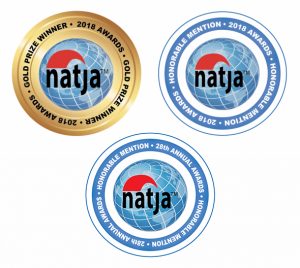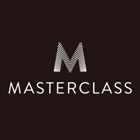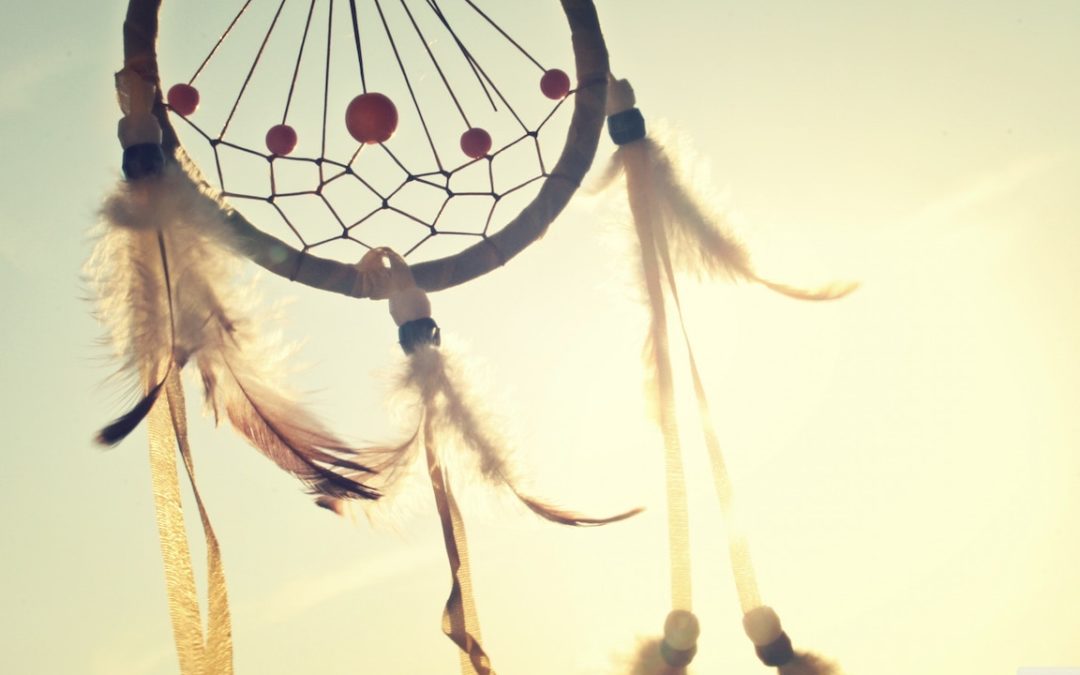
by Pat Wetzel | Jun 12, 2018 | Featured, Perspective, The Matrix, The Story
Alas, scanxiety is a constant companion; I can never fully escape the implications of life with cancer.
Last time I saw an oncologist was in 2016 and I was incredibly sick. I was vomiting and unable to keep food down. Throw in a bit of bright red blood, crippling stomach pains, and you get the picture.
I was absolutely distraught about what was going on in my life. I was losing what I perceived to be everything: my house, my family, my livelihood. The people who worked with me lost jobs; one had to file for bankruptcy.
Yet my oncologist did not ask even a single personal question. My circumstances and concerns didn’t factor into his care. He just suggested tests and more tests; he hinted at new cancers that might be arising; he needed to rule them out with a barrage of intrusive, inhuman technology. And let’s not forget the possibility of cancer as a result of previous treatment, and a correlation between lymphoma and other types of cancer.
But it didn’t take $30,000 worth of tests or a barrage of statistical studies. I knew what was wrong. It was December 2016 and I was under massive stress.
And the stress was literally killing me.
My decision to forgo any medical advice or intervention, sell my house and simply walk away isn’t one I necessarily recommend to anyone else. But for me, it was ultimately the right one. On some intuitive level I realized I needed to find a major reset.
Finding oneself (not totally broke) but homeless with cancer is most interesting.
You don’t want to look ahead to the implications of the incomprehensible stress and what it may mean for your future health. The past is past; the dye has been cast. No one know what lies ahead.
But in the moment, you are totally free. That is the magic and
The beauty of travel.
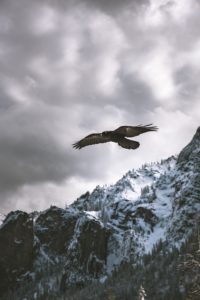
When flight sets you free. Photo credit: Casey Horner
So it has been, month after month, for a year now.
But it is June 2018 and I have decided I need some information about my health.
That means the scanxiety returns.
Is the cancer growing again? Did the stress of everything manifest itself in my body? If so, will I opt for treatment, or not?
What is on my absolute bucket list if my time is more limited than I’d like?
Yet how can I deal with yet another doctors office, where impersonal staff that asks the same questions again and again, and care only about payment? Where cancer patients sit passively in waiting room chairs, with the grey pallor of chemo on their skin and the chemical scent of death in the air? How can I deal with yet another disconnected doctor delivering gruesome news, without any understanding or care?
I can’t.
But I decide to go on a quest for an internist because I have decided I need some data about my health. And I may have found what I am seeking.
He is youngish. Fortyish I would guess. Which is a good age for a doctor. Seasoned, but still current. And he is of a generation that has more insight into life work balance. He has opted for a practice that allows him to be with his young family.
And he has a cancer story to tell, of his father who died at 48. He watched the treatments waste his father even faster than the cancer could. And he watched his father’s wishes for some peace in his time left ignored. He has lived the emotional terrain of this disease and he understands my scanxiety.
The doctor volunteers to run a blood panel for me, allowing me to avoid the oncology office, at least for now. At this point, I can read my own blood tests, but I let him deliver the results.
And I breathe.
Not perfect, but nothing of immediate life threatening concern.
I get through all these medical situations by bravely steeling myself, and dealing with what ever comes up. I live in my mind. My mind can read cancer studies, understand statistics, and make decisions. My mind can ignore my emotions.
But as soon as I leave, I deflate like a broken balloon. The stress and the uncertainty of scanxiety always dissolves into tears. This is a cycle and a response that I know too well. But I can’t seem to break it. It is how I handle this ghoulish sequence of repeating life events.
Perhaps because of these intervals of scanxiety, I have learned to live life in between much more fully. And with heart. Because heart felt living is part of the key to living well. Our mind may influence our biology, but our heart offers access to a deep well of wisdom within us.
So it’s ok if I cry. I don’t really cry enough, everything considered. The tears are a conduit for purging the stress from my system. I want to get out of my mind and into my heart and into the present, and tears are my path. My path to my soul.
When the heart weeps for what it has lost,
the soul laughs for what it has found.
–Sufi aphorism
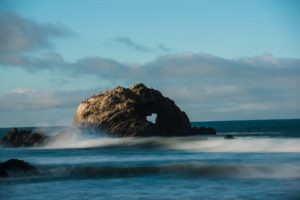
Photo by Casey Horner
***
In “When Breath Becomes Air” neurosurgeon Paul Kalanithi, when diagnosed with cancer, wrote of the relief of not dealing with so much competition and stress anymore. David Servan-Schreiber, MD,PhD (DSS) (diagnosed with a brain tumor) makes a similar observation. These successful, striving people were stopped in their tracks, forced to reassess their lives by a disease that would ultimately end them. DSS lived to be 50 or so. Paul died in his thirties. Faced with a dire cancer diagnosis, both faced choices about how they lived the rest of their lives. (See the CancerBookClub discussion here.)
I know how they both felt, about achievement, stress and accomplishment. And I understand how cancer can change our perspective on what creates a successful life.
How do we measure success? I look at my own attempts to navigate society’s matrix and I cringe:
In college, I spent a summer training for the squash team, to earn the number 2 place on the varsity squad (then lost it in a match played with the flu). I majored in finance at Wharton because it was the hardest thing to do. I commuted from Philadelphia to New York every day for more than a year, rising in the dark and returning home after dark, even in summer.
I worked insane hours at the behest of an incompetent boss. I outright lied about him in my exit interview to assure his ascent up the corporate ladder and my own good references. I did deals that made no sense because they were politically driven, not necessarily economically viable. I put aside nearly two decades of my life for a husband whose parting words were “I never loved you”. I gave and I gave and I gave and I came up empty again and again.
These mountains that you were carrying you were only supposed to climb
Najwa Zebian
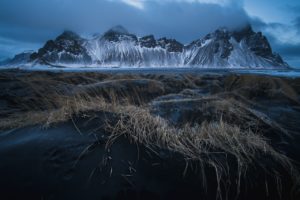
Photo by Cyrill Hänni
I suspect that I am not alone in some of these experiences. I performed for praise and for a place at the table. Little did I know I was sitting at the wrong table.
One has to ask, what are we doing to ourselves? Why do we persist in such obviously maladaptive behavior, generation after generation? What set of standards are we seeking and setting, individually and as a society?
In my own quest for health I have come to the conclusion that our lives and this matrix we live in are far unhealthier than we even image.
Mental health is never addressed until someone blows up. Many of us live with decades of psychological pain buried, unbeknownst to ourselves, in our bodies. We act out this pain again and again, going nowhere.
Glyphosate invades our food supply. It’s in the soil in Napa. These and other chemicals and opioid drugs are found in our water.
We are social creatures, yet community is a buzz word, often far removed the reality of life where our garage and elevator doors open and close behind us, and processed food can be delivered to our door.
We are externally oriented, driven by baubles and bubbles.
We buy into society’s matrix, believing it is real, and in doing so ignore the deep reservoirs of human knowing within.
And 40% of us will get a cancer diagnosis. Not to mention a host of other diseases.
What’s wrong with this picture?
“If you do not change direction, you may end up where you are heading.”
–Buddha
Ask yourself: How do you care for yourself? Your family? Are you connected to your soul?
Ask your heart. Then be still and just listen.
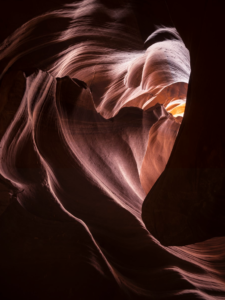
Let your heart lead you to your own inner wisdom
***
Travel is the perfect metaphor for a journey within. Even if one must go down the rabbit hole of scanxiety. I suspect I will always be juggling scanxiety and my own contrary desires for ignorance and information. I think I am coming to err on the side of information once again, so I am moving towards resolution, whatever that may be, at least for the moment.
Cancer sucks. There is no debating that. It is a death of sorts. But it’s also life because there is wisdom to be found in the experience. If you could reexamine and remake your life, what would you choose?
Would it be houses and cars and clothes? Status and stuff?
Or would you choose to respect the earth and our food? Your own body and choices? Would you choose beauty? Harmony? Love?
How would those choices impact those around you?
Be the change you want to see in the world.
–Mahatma Gandhi
Change starts one person at a time. Never underestimate the impact you can have on others. Never underestimate the power of a single step.
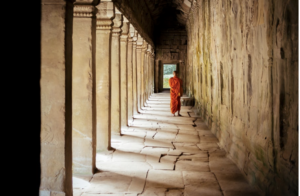
A journey of a thousand miles starts with a single step.
***
Many ancient civilizations have a wisdom that we seem to have lost in the busyness of our lives. It is one of the things that fascinates me about perspectives on health and healing. What can we learn from the past to move us forward, in our world today?
The Ka Ta See of South America note that:
“The people of this planet are forgetting how to experience outside the tyrannical habits of their minds.”
Thirty years ago I would not have understood this. I was mired in a matrix of accomplishment, status and stuff. I knew something was missing. I just didn’t know it was me.
It was flying that opened my eyes to the world because it opened the world to my soul. That ridiculously rash act of joining MASA, buying a “hot” plane and learning to fly became a pivot point in my life experience. I used to paraphrase the best selling book, All I Really Need to Know I Learned In Kindergarten, with All I Really Need to Know, I Learned Flying.
And all the lessons were there. It embodied risk and responsibility; fearlessness and trust; independence and interconnection; the power of the earth versus the ego of man; the beauty of the soul.
The experience of the earth from above, navigating by the invisible powers of the sky, is nothing short of astounding.
My soulful journey started in the sky. It was restarted with a cancer diagnosis, and now a travel quest. Because I’m always up for a bit of adventure. And in travel and in the quiet of my soul, I seem to find it.
Joan Halifax in her new book Standing At The Edge Finding Freedom Where Fear and Courage Meet talks about the fact that as humans, we are always in free fall. She writes: “It’s not like we will find some moral high ground where we are finally stable…It’s more like we are all falling above the infinite groundlessness of life, and we learn to become stable in flight…The final resting place is not the ground at all but rather the freedom that arises from knowing there will never be a ground, and yet here we are…navigating the boundless space of life”.
Wise words from a renown Buddhist monk.
The American Indians of the southwest also have a legacy and a culture of great wisdom, tied to the timeless wisdom of the earth. And so I choose to leave you with this quote from Chief Tecumseh. It’s a bit long, but worth reading:

Dream Catcher Photo Credit: PhotoDyaa Eldin
“So live your life that the fear of death can never enter your heart. Trouble no one about their religion; respect others in their view, and demand that they respect yours. Love your life, perfect your life, beautify all things in your life. Seek to make your life long and its purpose in the service of your people. Prepare a noble death song for the day when you go over the great divide. Always give a word or a sign of salute when meeting or passing a friend, even a stranger, when in a lonely place. Show respect to all people and grovel to none. When you arise in the morning give thanks for the food and for the joy of living. If you see no reason for giving thanks, the fault lies only in yourself. Abuse no one and no thing, for abuse turns the wise ones to fools and robs the spirit of its vision. When it comes your time to die, be not like those whose hearts are filled with the fear of death, so that when their time comes they weep and pray for a little more time to live their lives over again in a different way.
Sing your death song and die like a hero going home”
–Chief Tecumseh (Crouching Tiger) Shawnee Nation 1768-1813
Scanxiety, Cancer and Reading–Three of My Favorite Soulful Books
Learning to live with the uncertainty of cancer and the certainty of scanxiety, I have tried to find some balance between stress (like my scanxiety experience above) and day to day life. Recognizing the lack of control we actually have is eye opening, and I choose to see it not as worrisome, but as opportunity. If I have NO control, what might come up? I look for the interesting and serendipitous, and it tends to take me good places.
And I read constantly. In this age of the two minute video, I make it a point to cultivate a more enduring attention span. Here are some of the books that have touched me or that travel with me. Drop me a line (twitter or email or a comment below) and share your favorites! I’m always looking for good reading.

 I love this book for its depth of soul and deep wisdom.
I love this book for its depth of soul and deep wisdom.
From Amazon:
“I recommend this book highly to everyone.” –Deepak Chopra, M.D.
“Despite the awesome powers of technology, many of us still do not live very well,” says Dr. Rachel Remen. “We may need to listen to one another’s stories again.” Dr. Remen, whose unique perspective on healing comes from her background as a physician, a professor of medicine, a therapist, and a long-term survivor of chronic illness, invites us to listen from the soul.
This remarkable collection of true stories draws on the concept of “kitchen table wisdom”– the human tradition of shared experience that shows us life in all its power and mystery and reminds us that the things we cannot measure may be the things that ultimately sustain and enrich our lives.


 It’s interesting that the first time I read When Breath Becomes Air, I thought, “oh no, another doctor finally discovers his mortality”. But I read it again for CancerBookClub and it is a wonderful book. I found myself deeply relating to Paul’s predicament of having his life ripped out from under him. If you read it, make note of Emma, the oncologist. Now that is a wise woman!
It’s interesting that the first time I read When Breath Becomes Air, I thought, “oh no, another doctor finally discovers his mortality”. But I read it again for CancerBookClub and it is a wonderful book. I found myself deeply relating to Paul’s predicament of having his life ripped out from under him. If you read it, make note of Emma, the oncologist. Now that is a wise woman!
From Amazon:
At the age of thirty-six, on the verge of completing a decade’s worth of training as a neurosurgeon, Paul Kalanithi was diagnosed with stage IV lung cancer. One day he was a doctor treating the dying, and the next he was a patient struggling to live. And just like that, the future he and his wife had imagined evaporated. When Breath Becomes Air chronicles Kalanithi’s transformation from a naïve medical student “possessed,” as he wrote, “by the question of what, given that all organisms die, makes a virtuous and meaningful life” into a neurosurgeon at Stanford working in the brain, the most critical place for human identity, and finally into a patient and new father confronting his own mortality.
What makes life worth living in the face of death? What do you do when the future, no longer a ladder toward your goals in life, flattens out into a perpetual present? What does it mean to have a child, to nurture a new life as another fades away? These are some of the questions Kalanithi wrestles with in this profoundly moving, exquisitely observed memoir.


 Those that follow this blog know that I’ve become an Eckhart Tolle fan. And this book can be life changing. It echoes wisdom from the past, and incorporates Tolle’s own unique insights and experiences on spirituality and mental health. Not necessarily the easiest read, but IMO a must read.
Those that follow this blog know that I’ve become an Eckhart Tolle fan. And this book can be life changing. It echoes wisdom from the past, and incorporates Tolle’s own unique insights and experiences on spirituality and mental health. Not necessarily the easiest read, but IMO a must read.
From Amazon:
To make the journey into the Now we will need to leave our analytical mind and its false created self, the ego, behind. From the very first page of Eckhart Tolle’s extraordinary book, we move rapidly into a significantly higher altitude where we breathe a lighter air. We become connected to the indestructible essence of our Being…Although the journey is challenging, Eckhart Tolle uses simple language and an easy question and answer format to guide us.
A word of mouth phenomenon since its first publication, The Power of Now is one of those rare books with the power to create an experience in readers, one that can radically change their lives for the better.
More On the Emotions Of CancerRoadTrip:
Weathering The Storm
Traveling The Timeline Of Now
More Thoughts On The Metaphor Of A Road Trip
Life in Six Month Increments
11 Life Lessons Learned From The Road
Like This Post? Pin It!
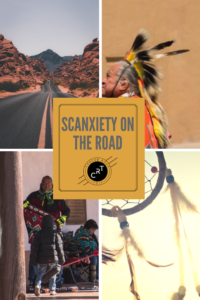
If you’re interested in learning more about photography (or cooking or film or any number of topics) check out MasterClass All-Access Pass for on-line excellence:

[et_bloom_inline optin_id=”optin_10″]
What is #CancerRoadTrip and how did it come to be? Read this post to get the backstory!
Follow me on Twitter, Pinterest, Instagram, and at Anti-Cancer Club. Connect with me! I may need a place or two to stay along the way!
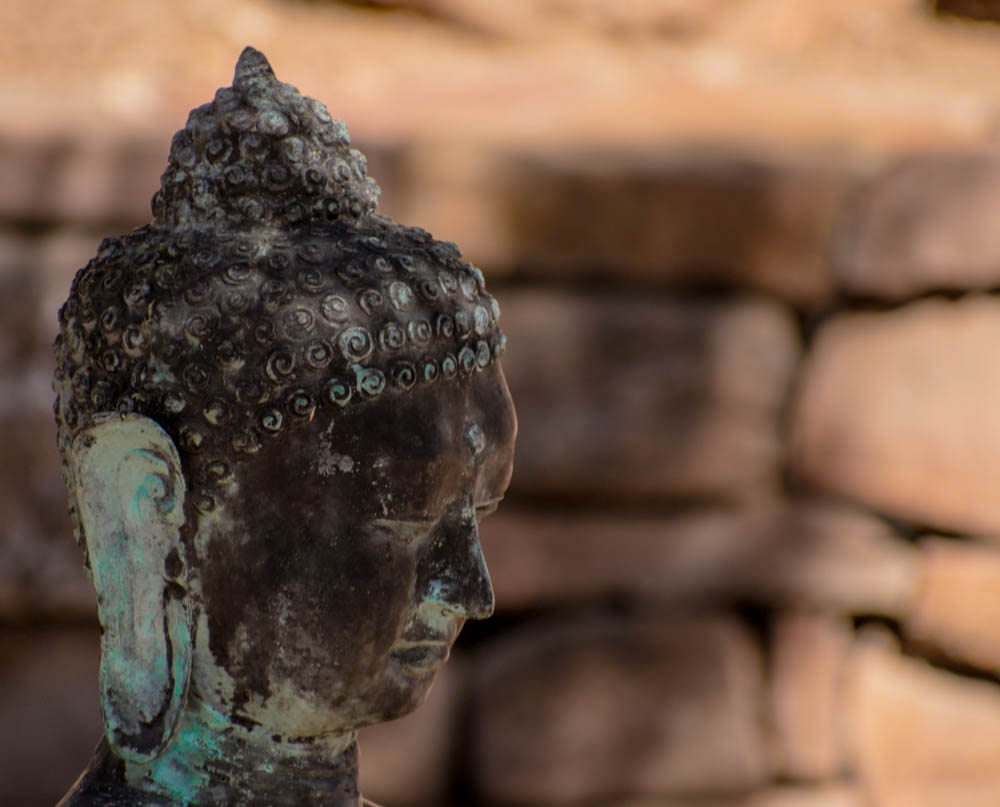
by Pat Wetzel | Mar 12, 2018 | Featured, Road Trip, Santa Fe, The Story
Have you been curious about a zen retreat, such as meditating at Upaya or perhaps visiting Tibet?
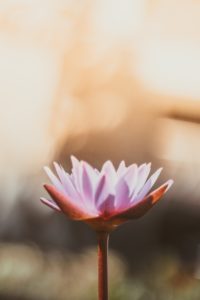
Photo credit: Ahmed Saffu, Unsplash
Images of smiling Buddhist monks, flowing robes and the sounds of beautiful bells probably come to mind. Chirping birds, beautiful pathways, flowers and fresh air.
And silence, as the monks pursue their tasks and meditate.
The Buddists use meditation as part of their quest for enlightenment. Meditation has no religious overtones. Like its counterpart mindfulness, it is simply about being still and quiet in this busy world. The benefits of stopping to be still can be considerable.
It was the healing aspects of meditation coupled with a need to manage stress and life with cancer that caused me to start exploring this path. Learning to meditate and incorporating its benefits into my daily routine has changed my life.
Someone recently asked me about meditation and why I found it so powerful. Let me try to conjure up an analogy:
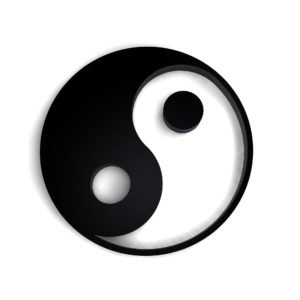
The yin and yang of black and white
First, imagine you only see white.
Think of white as the constant noise of TV, conversations, life in general. In white there are market lists, to do lists, thoughts about the past and the future. Your mind jumps from topic to topic, conversation to conversation, past to future. The mental buzz is unending. It’s society’s matrix and its probably where you spend most of your time.
Now introduce black.
There is stillness.
There are no lists or noise, no distractions or requirements, no past or future.
Just stillness. You feel the peace and serenity.
Pause and consider that for a moment.
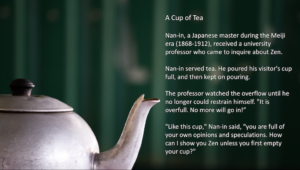
The Zen Koan, A Cup of Tea
In peace, in the absence of (psychological) time, there are no thoughts. The quiet you find is extraordinary. Revolutionary. Game changing.
Observe your thoughts. Let them fall away.
At first this stillness may be elusive, but with practice, you can learn to take it with you, wherever you go.
The trick is navigating the external matrix without losing the internal stillness.
So it is that meditation is part of my daily routine. And this Sunday I joined a half day “sit” at Upaya, called “The Ease and Joy of Mornings”.
Upaya is a well known zen monastery and retreat in the hills above Santa Fe. It is accessed via an un-prepossessing, unpaved road. Clouds of dust rise as a car passes and a dirt driveway appears dropping off steeply to the right.
Welcome to Upaya
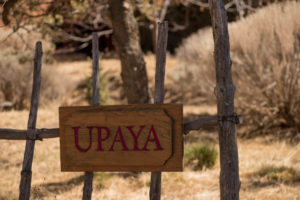
A simple sign outside the Zen monastery greets the visitor
A friend had invited me to three hours of Zazen (sitting meditation) broken with intervals of Kinhin (Walking Meditation). Meetings are held in the zen-dō, a spiritual dōjō where meditation is practiced.
This was my first Zen “sit” and I approached it with curiosity and the hope that a three hour session won’t be too much for my chemo joints or my sometimes busy mind.
The word “Zen” derives from the Sanskrit word “dhyana” which translates into “meditation” or “absorption.” In Chinese, the word is “Chan”; in Japanese, “Zen”.
Zen is a form of Buddhist meditation—there is nothing to believe in, and nothing special to do or be. One need not wear robes or shave one’s head. One is simply present.
Upaya Institute and Zen Center is one of several Buddhist monasteries in the area. It’s not a fancy place. The accommodations at the monastery are, well, monastic.
On the surface, the monastery and Zen Center radiant peace, but a brief look at the schedule shows what a culturally and intellectually dynamic place Upaya is.
On the peaceful side of the equation, daily meditations are open to the public at 7:00 am, 12:20 pm and 5:30 pm and one is warmly welcomed.
On the intellectual and cultural side of the equation, Upaya simply rocks. Weekly talks and programs on topics ranging from Buddhist teachings to art, neuroscience and other topics are offered to anyone who would like to attend. Wednesday evening Dharma talks are also open to the public.
But my interest this day is on experiencing an extended morning of meditation at this beautiful retreat.
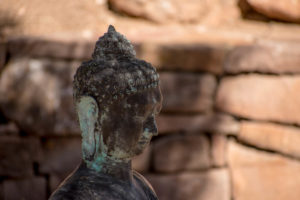
A mediating statue outside the entrance to the zendo
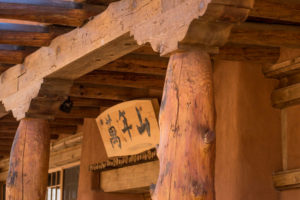
The entry to the Upaya zendo or meeting hall.
The atmosphere is kind, open and friendly. A good number of participants this morning were newbies like myself. In addition to cushions, chairs are placed along the wall, should sitting for extended periods be difficult. Many of us choose a chair, myself included.
Petra Hubbeling from Holland leads the group. She visits Upaya twice a year, for three months each visit. Her background of thirty years in business recruitment and management is in contrast to her current life in training a student in Upaya’s Chaplaincy Program. She reflects on her first visit:
“Being at Upaya that first time, I felt how every guest practitioner who comes here feels. I fell in love with this place, with the beauty of the center, with the beauty of the practice, with Upaya’s deep commitment to social engagement.”
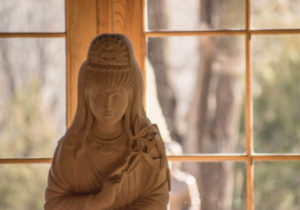
Light spills through the window into the sunroom
Petra outlines the morning agenda, explaining some of the monastery’s traditions, and we settle in to meditate in silence until the soft resonance of the gong sounds. About forty minutes, I would guess. Time does not matter. One of the apprentices is tasked with monitoring the clock. Our only task is to be present in our meditation.
“Real Zen is the practice of coming back to the actual right-now-in-this-moment self, coming back to the naturalness, the intimacy and simplicity of our true nature. Zen practice is not about getting away from our life as it is; it is about getting into our life as it is, with all of its vividness, beauty, hardship, joy and sorrow. Zen is a path of awakening: awakening to who we really are, and awakening the aspiration to serve others and take responsibility for all of life”. -Upaya website
The sound of the gong wafts gracefully through the zendo and indicates it is time to move from our still minds to our bodies, all in silence except for some instruction from Petra. We bow first to our place of meditation, then to the room. And single file, we start to walk.
“Fast, faster”, Petra beckons. “Follow the person before you. Move as they move.”
The pace quickens and the human line weaves through the zendo, into the sunroom and back.
“Now walk slowly.” The cadence changes. “Align your movement with the person in front of you. Follow your breath.”
Now the entire human line slows, in step with each breath. Each movement is exaggerated with great awareness. From heal to toe and back again. Slowly. The goal is to have the entire line move as one, with a collective awareness of each move.
We weave in a line from the zendo to the sunroom and back. The room moves as one and we return for another period of Zazen followed by another period of Kinhin . Then we break for some tea and snacks in the kitchen.

Photo Credit: by Nathan Burrows on Unsplash
The kitchen is busy and welcoming, as students mindfully chop vegetables, cook meals, wash dishes and sweep the floor. Off the kitchen, there is a smaller indoor dining area a step down, for daily dining. There is also a long patio overlooking the grounds for larger groups. We gather here until returning to the zen-dō for a discussion about the traditions of this morning sit.
Upaya was founded in 1994 by Roshi Joan Halifax, PhD. This remarkable woman is a Buddhist teacher, Zen priest, anthropologist, and a pioneer in the field of end-of-life care. She has been an Honorary Research Fellow at Harvard and a Distinguished Visiting Scholar at the Library of Congress.
Professionally and spiritually, she has focused on the psycho-social, ethical and spiritual aspects of care of the dying, particularly with cancer patients. Her influence on the field of spirituality, medicine and compassion cannot be overstated.
I have to say I am humbled, amazed and grateful to have access to such an amazing educational and cultural institution in my back yard.
The upcoming Upaya schedule for this Spring includes programs such as Rediscovering Zen’s Roots in Ancient China by philosopher and Columbia University teacher David Hinton; and a two week Japan Arts Pilgrimage, Ancient and Contemporary Art and Sacred Sites, with Roshi Joan Halifax. A full schedule of events is here.
Upaya is just one of several Zen monasteries in Santa Fe. While I’m taken with this incredible zen center, I also look forward to exploring the others. I think my interest lies in the wonderful ambiguity associated with the Buddhist train of thought, along with my already established meditation practice. I don’t see myself running off to a monastery (too many restaurants to discover!), but I am drawn to the recognition of impermanence that we all seem to seek to avoid.
In the words of the 8th-century Buddhist master Shantideva (The Way of the Bodhisattva):
All that I possess and use
Is like the fleeting vision of a dream.
It fades into the realms of memory;
And fading, will be seen no more.
–Tricycle: The Fundamental Ambiguity of Being Human
If you’re interested in some reading on meditation and mindfulness:


 This is the first book I recommend to everyone curious about meditation. The author asks you to set aside just 8 minutes a day. Week by week, he introduces new approaches to meditating. It gives you the chance to sample some different bodies of thought and decide which–if any– might suit you. An excellent place to start, and one of my first books as well!
This is the first book I recommend to everyone curious about meditation. The author asks you to set aside just 8 minutes a day. Week by week, he introduces new approaches to meditating. It gives you the chance to sample some different bodies of thought and decide which–if any– might suit you. An excellent place to start, and one of my first books as well!


The Power of Now is one of the most amazing books ever. Eckhart Tolle’s personal story takes him from homelessness to spiritual teacher.
From Amazon:
“To make the journey into the Now we will need to leave our analytical mind and its false created self, the ego, behind. From the very first page of Eckhart Tolle’s extraordinary book, we move rapidly into a significantly higher altitude where we breathe a lighter air. We become connected to the indestructible essence of our Being, “The eternal, ever present One Life beyond the myriad forms of life that are subject to birth and death.” Although the journey is challenging, Eckhart Tolle uses simple language and an easy question and answer format to guide us.
A word of mouth phenomenon since its first publication, The Power of Now is one of those rare books with the power to create an experience in readers, one that can radically change their lives for the better.”
If you haven’t read this, download it NOW! It’s one of those books you’ll come back to again and again.


This book is a classic for a reason. It’s about integrating mindfulness meditation into everyday life. It’s been updated with a new afterward by the author.
More Posts about Zen and Travel:
Winter Zen in Santa Fe: Upaya and Ojo Caliente
Thoughts on the Metaphor of a Road trip
11 Life Lessons Learned From the Road
Traveling the Timeline of Now
Travel Packing List: Quotes, Wisdom and a Minimum of Luggage
Travel Minimalist: 17 Reasons Why Less is More
Reflections on Life With Cancer
Aparigraha
Like This Post? Pin It!
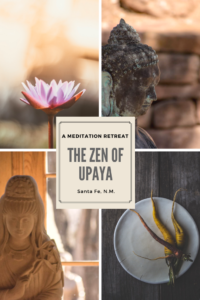
If you’re interested in learning more about photography (or cooking or film or any number of topics) check out Masterclass for on-line excellence:

[et_bloom_inline optin_id=”optin_10″]
What is #CancerRoadTrip and how did it come to be? Read this post to get the backstory!
Follow me on Twitter, Pinterest, Instagram, and at Anti-Cancer Club. Connect with me! I may need a place or two to stay along the way!

by Pat Wetzel | Feb 5, 2018 | Featured, Road Trip, Santa Fe, The Story
In Santa Fe, a casita is a common form of housing:
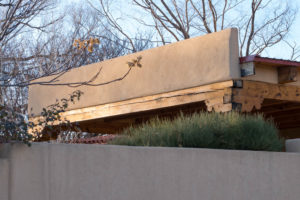
Adobe building peaks from behind the compound walls
Casita (noun): A small house or other building (especially in the US Southwest)
ca•si•ta
kəˈsēdə/
Origin: early 19th century: from Spanish, diminutive of casa ‘house.’
I am staying at a charming casita on a one acre compound. Casita is a diminutive of casa which means “house” in Spanish.
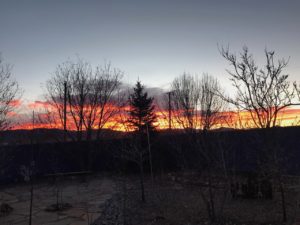
The morning dawn over the Sangre de Cristo Mountains from the back porch of my little casita
Mornings I’m greeting by a soulfully blue adobe wall that surrounds the property. Above and to the east, I watch the sun rise as the day dawns over the Sangre de Cristo Mountains.
The Casita is small but beautifully turned out: a bedroom and bath and a small but functional kitchen and sitting room. I set my computer on the rolling island in the kitchen, pull up a stool, and I’m in business.
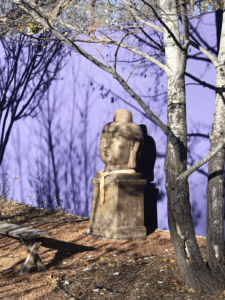
Within the casita compound, restful places to pause and be still abound. The interior compound wall is painted a beautiful blue.
A casita sounds luxurious and exotic but this type of living arrangement isn’t uncommon in Santa Fe and with the advent of AirBnB, it’s become a substantial income for many.
Staying here is not cheap; it is not a long term solution. But it is a fabulous way of landing in Santa Fe for now.
I’m just under 10 minutes from the plaza, just a few miles—there isn’t necessarily a lot of traffic here, but it can be painfully slow. Traffic, like much of NM, adheres to the manyana school of time.
A recent road trip to Reno, NV and back to pick up a few things underscored the vast distances of the west.
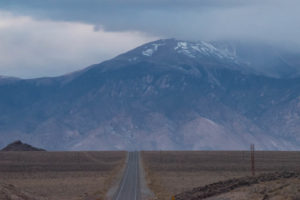
Road trip!
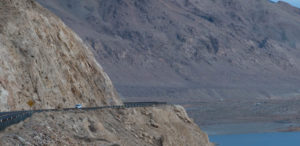
The road winds around Walker Lake, NV
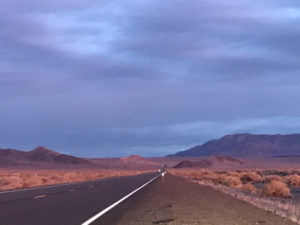
Road Trip! Route 95 North in Nevada
The relative isolation of this Santa Fe becomes more evident with time. Mile after mile of southwestern landscape rushes by, mile after mile of desert and high desert with few towns in between.
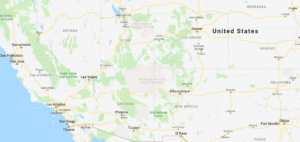
The distances between cities become vast in the American West
Isolation can be good and bad. In this day of instant communication and connection a bit of physical isolation feels good if you like your locale. And many people in Santa Fe love it here.
I am one of them.
The downside: travel anywhere means a bit of a drive or a flight. And it may be a bit more expensive and time consuming as well.
Time is a strange concept in this timeless place. There is no metropolis nearby to create a sense of shortage or urgency. Life simply unfolds at its own pace. If you pay no mind to the shrieking heads on television or the relentless pounding of advertisements (ie. unplug the box!), life is peaceful.
Santa Fe has a reputation of being snooty, arty and woo. And it is. But it’s also earthy, beautiful and soulful. Take your pick on your point of view and your experience.
Morning sunrises are just gorgeous. There is little pollution in this city at 7,000 feet which traces its roots back over a thousand years before the Spanish “founded” the town in 1610. The air is clean and this time of year, cold in the early morning and late afternoon into evening. But mid day, even on a “cold” day, it is lovely. The warmth of the sun overcomes any vestiges of winter and it’s a pleasure to be outdoors.
Because in addition to art, culture and history, the outdoors in this area is world class.
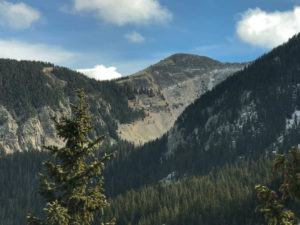
The outdoors in and around Santa Fe, Northern New Mexico is world class
I’ve only begun my explorations. Some locales like Kasha-Katuwe Tent Rocks National Monument deserve a dawn arrival that may be better done in the spring. Ghost Ranch, just an hour north, is a bit easier to access now.

Ghost Ranch, NM, The American West
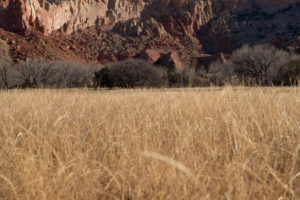
Hiking the American West at Ghost Ranch, NM
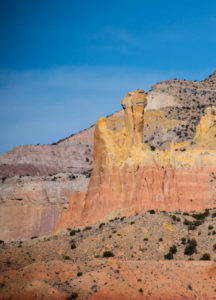
Ghost Ranch offers some of the most stunning geography in The American West
Ojo Caliente (a world class spa) is nearby, if you can tear yourself away from the incredible geography. Taos in any season offers a spectacular trip into time.
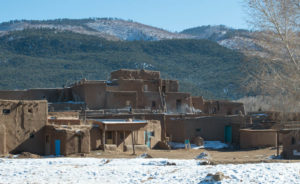
Pueblo, Taos New Mexico
And on any given day, I am happy to just walk the streets of this charming town, chat with people (everyone is incredibly friendly) and explore.

Just off the Plaza, a covered walk in Santa Fe, decorated for Christmas
Traveling has rewired my “needs”. With less, life is so much simpler. Without ownership, I have no maintenance concerns. I need to pay my rent and feed myself.
And, of course, have a bit of fun.
Landing in Santa Fe I have found a vibrant film industry. Efforts to build the industry date back some years, and a good infrastructure has been developed that encourages and mentors young people interested in film and offers incentives that lean towards local hires. A win/win for everyone.
Especially CancerRoadTrip.
I will be basing the first CancerRoadTrip here in Santa Fe. There is a zen monastery in the hills overlooking town that offers a wonderful retreat for daily meetings. Staying near the Plaza offers endless museums, restaurants and shopping. Combined with our thought leaders from a variety of health oriented disciplines, a healing retreat in Santa Fe may be just what the doctor ordered. I mean, do you know anyone that has had to deal with cancer who couldn’t use a healing retreat?
“Healing is a matter of time, but it is sometimes also a matter of opportunity.” – Hippocrates
In pausing for a bit in one locale, I know I feel a need to stop and heal. The constant travels of the past months have been tiring at times. This week, in addition to film meetings and writing, I am taking the time to meditate, to walk and to get my body moving. In just a few days, I already feel the difference. I am once again focused on organic, low glycemic, healthy eating, and the impact is noticeable.
Sadly, it took the illness of a new friend here in Santa Fe to make me slow down. She survived ovarian cancer a few years ago, but found herself run down and exhausted this past month. She’s now in the hospital.
I am worried. I worry about all my “cancer friends” because I know what they have lived through, and what they may be facing. I fear for them, as I fear for myself. I do not want to join these ranks again, just yet. I want to stay healthy for a bit longer; I want to enjoy my travels; I want to get CancerRoadTrip up and running for others in the cancer community.
So, as far as I may travel, I travel with myself and with the timeless truths of good health: good food, movement, meditation, and community. And here in Santa Fe I seem to be readily finding it all.
More on my travels to Santa Fe:
Santa Fe via Las Vegas, N.M.
Photo Mission: Cold
Photo Mission: Winter at Taos Pueblo
The Art, Culture and Beauty of Santa Fe, N.M.
Ojo Caliente, Wind Chimes and Waters
The Zen of Upaya
Warming Up To Restaurant Week in Santa Fe
Like This Post? Pin It!
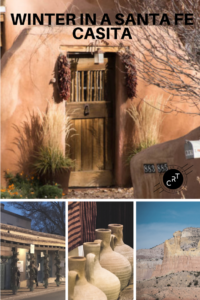
Winter in a Santa Fe Casita
If you’re interested in learning more about photography (or food or film or any number of topics) check out Masterclass for on-line excellence:

[et_bloom_inline optin_id=”optin_10″]
What is #CancerRoadTrip and how did it come to be? Read this post to get the backstory!
Follow me on Twitter, Pinterest, Instagram, and at Anti-Cancer Club. Connect with me! I may need a place or two to stay along the way!
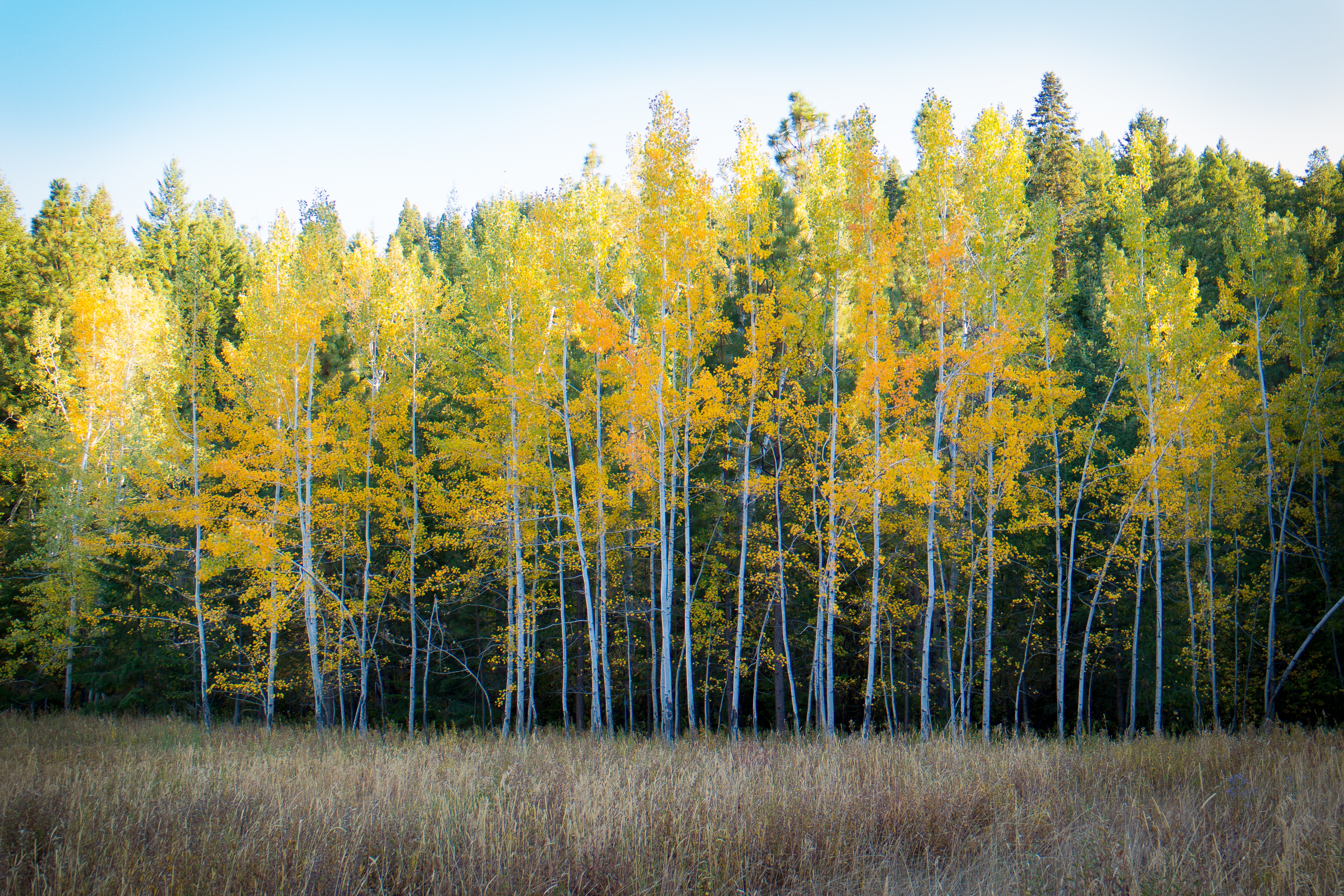
by Pat Wetzel | Jan 4, 2018 | Featured, Perspective, Road Trip, The Story
“Two roads diverged in a yellow wood,
And sorry I could not travel both
And be one traveler, long I stood
And looked down one as far as I could
To where it bent in the undergrowth;
I shall be telling this with a sigh
Somewhere ages and ages hence:
Two roads diverged in a wood, and I—
I took the one less traveled by,
And that has made all the difference.”
–Robert Frost, The Road Not Taken
I am always moved when I read this poem. I feel as though Robert Frost stood not just at a parting roadway, but perhaps a roadway with one path to the future and one to the past. But only the path forward, the path into uncertainty, was worth taking.
It is the beginning of a new year. I am grateful. And in gratitude, I take the time to look back and to look ahead.
What wisdom comes from six months of travel, six months without a home or an endpoint? Without certainty, possessions or security of place?
What have I learned? Here are some of my go-to lessons to cope with life, travel and, oh, yeah, cancer!
Some Lessons From The Road
Life Lesson #1: Have A Sense of Adventure
Some travel to take tours.
I say travel for the detours!
Set sail, and go with the wind. I actually knew a pilot that would simply take off and fly into high pressure (i.e. good weather). He landed wherever he landed. He visited the most unusual places!
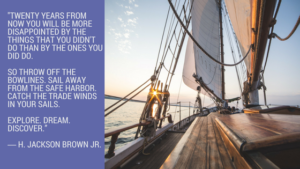
Travel for life’s detours!
Life Lesson #2: Take The Time To Be Still
Only when you’re still can you progress. I know that sounds contradictory, but consider: A life well lived implies some creativity and creativity needs quiet to take root and grow. Quiet is nurturing; restorative.
Sometimes it is the change of place that allows one peace. That’s where travel comes in.
To capture that peace day to day, that’s where discipline comes into play. (see Life Lesson #9)
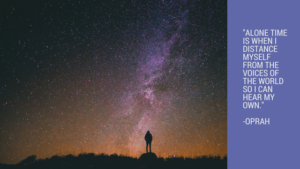
Wisdom from Oprah
Life Lesson #3: Believe In Yourself
Look to your own inner guidance. Believe in it.
The most powerful voice is the one that lives in your head. Learn to calm your mind; observe your thoughts. Learn to carefully craft them as well. This is a conscious choice, one that involves ongoing effort. (See Life Lesson #9)
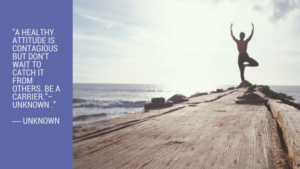
Healthy Attitude
Life Lesson #4: Be Optimistic
According to Oscar Wilde : “The basis of optimism is sheer terror”.
I laughed (see Life Lesson #7) when I read this because there are days when I have to agree.
I like to think of optimism as positive energy. It’s where I prefer to dwell. And why not? It takes considerably less energy than living in fear; it’s fun; it is the energy that makes good things happen. Optimism means taking the time to dream, and pursuing those dreams.
Optimism alone isn’t a cure all. (See Life Lesson # 9). But the energy it creates can drive events and it certainly makes the journey much more fun. (See Life Lesson #7 again and be sure to at least smile).
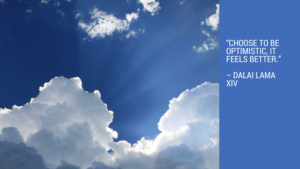
Optimism from the Dalai Lama
Life Lesson #5: Be True To Yourself
Only in truth, do we find our way. Stop, be still, listen to yourself. (see Life Lesson #2 and #3).
Life is short. Live it well.
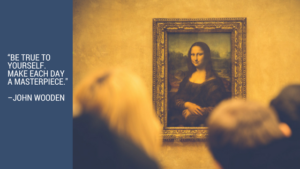
Make Each Day A Masterpiece
Life Lesson #6: Choose Beauty
Beauty is everywhere if you choose to see it. It pleases the eye and fills the soul. Do you choose to see it?
And if so, did you notice, that it’s hardly “perfect”?
Perfectionism robs us of beauty. Instead we look for flaws. And they’re always there if that’s what you’re seeking.
When I saw the picture below, and the weeds in the field of flowers, it seemed perfect to capture the essence of this life lesson:
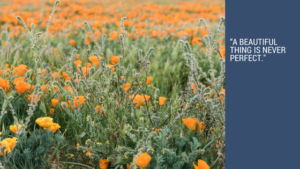
Beauty is wonderfully imperfect.
Life Lesson #7: Have Fun
Make fun a priority. It’s really quite easy. First it’s a decision; secondly it’s an outlook. It becomes a mindset.
I’m not talking about partying ’til dawn. Fun can be gentle, quiet and kind. I’m talking about enjoying the moment here and now.
How does one survive life– much less cancer!– without a sense of humor and fun? Make it a habit to cultivate both.
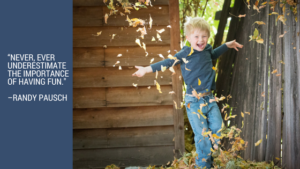
Remember to laugh and play
Life Lesson #8: Be Curious
Be ready for some twists and turns; be prepared to double back on yourself, and always be learning! Learning breeds curiosity, curiosity makes us focus and with focus we can enter “the flow”, that wonderful, timeless place of maximum creativity and productivity. Only in the flow of life can serendipity occur.
Curiosity breeds serendipity.
Embrace both.
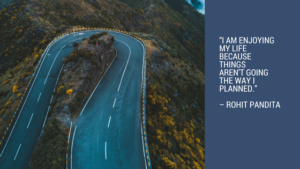
Only in the flow of life can serendipity occur.
Life Lesson #9: Be Dogged
Things do not magically happen. On a daily basis, do what must be done. Meditate. Work. Eat well. Be persistent even when the climb seems insurmountable.
An old Zen saying:
“Before enlightenment, chop wood, carry water.
After enlightenment, chop wood, carry water.”
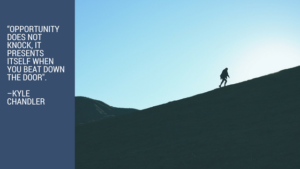
Baby Steps and Perseverance
Life Lesson #10: Embrace Change
For whatever reason, change is hard for most of us. Yet staying stuck in an outdated past can be deadly on so many levels.
Why not learn to cultivate curiosity about change and integrate it into your life? Since change is inevitable, why not make it pleasurable as well? (see Life Lessons # 1, 3, and 5)
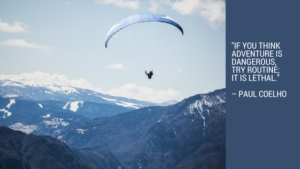
Life Lesson #11: Be In The World But Not Of The World
This is a saying attributed to the Bible (which I must admit I’ve not read–organized religion just isn’t my thing). And it’s one of my favorite phrases.
To me it speaks of being here, now. Being fully alive. But remembering that the meaning in the experience isn’t the trend du jour, the bigger house, the newest car or the coolest electronic.
The meaning in life comes from within.
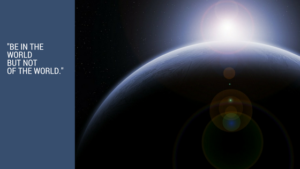
Wisdom transcends time.
To looking within; To helping out.
Looking ahead to 2018, May it be a year of prosperity, wisdom and peace for all of us.
Like This Post? Pin It!
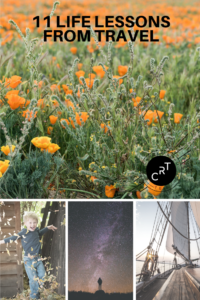
11 Life Lessons From The Road
If you’re interested in learning more about photography (or cooking or film or any number of topics) check out Masterclass for on-line excellence:

[et_bloom_inline optin_id=”optin_10″]
What is #CancerRoadTrip and how did it come to be? Read this post to get the backstory!
Follow me on Twitter, Pinterest, Instagram, and at Anti-Cancer Club. Connect with me! I may need a place or two to stay along the way!







I love this book for its depth of soul and deep wisdom.
It’s interesting that the first time I read When Breath Becomes Air, I thought, “oh no, another doctor finally discovers his mortality”. But I read it again for CancerBookClub and it is a wonderful book. I found myself deeply relating to Paul’s predicament of having his life ripped out from under him. If you read it, make note of Emma, the oncologist. Now that is a wise woman!
Those that follow this blog know that I’ve become an Eckhart Tolle fan. And this book can be life changing. It echoes wisdom from the past, and incorporates Tolle’s own unique insights and experiences on spirituality and mental health. Not necessarily the easiest read, but IMO a must read.
















































